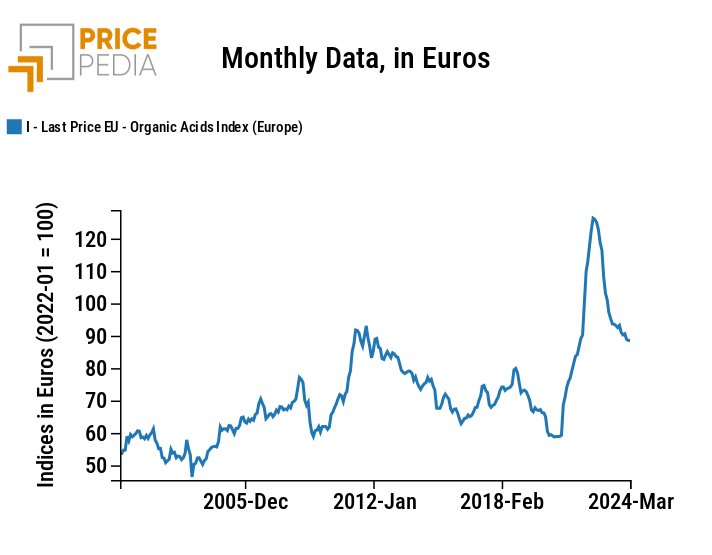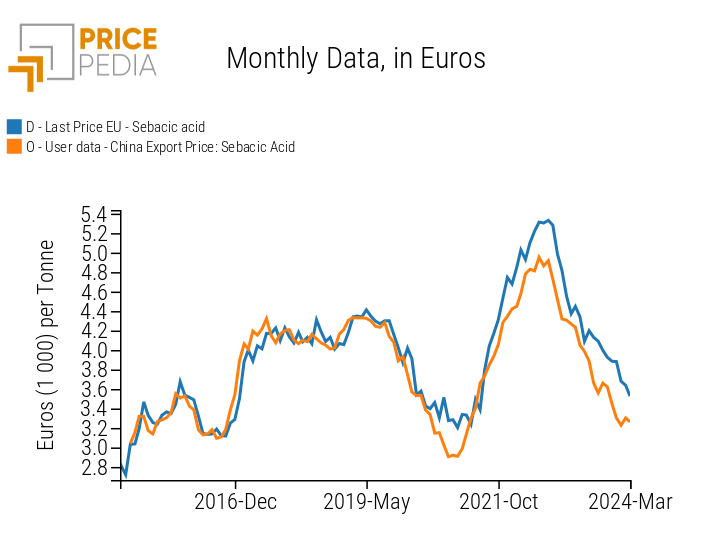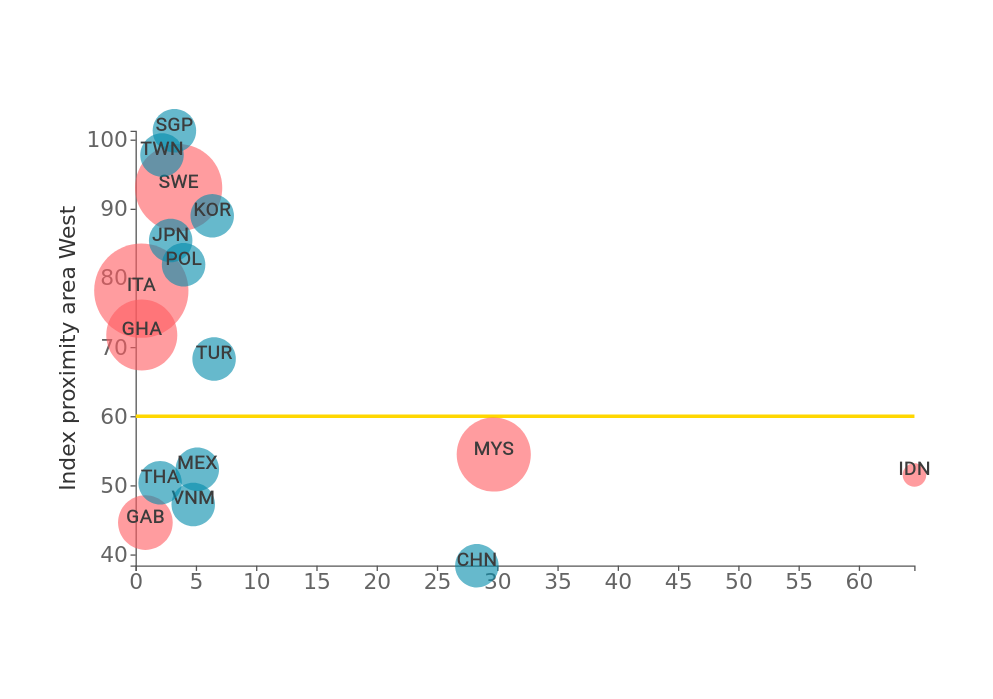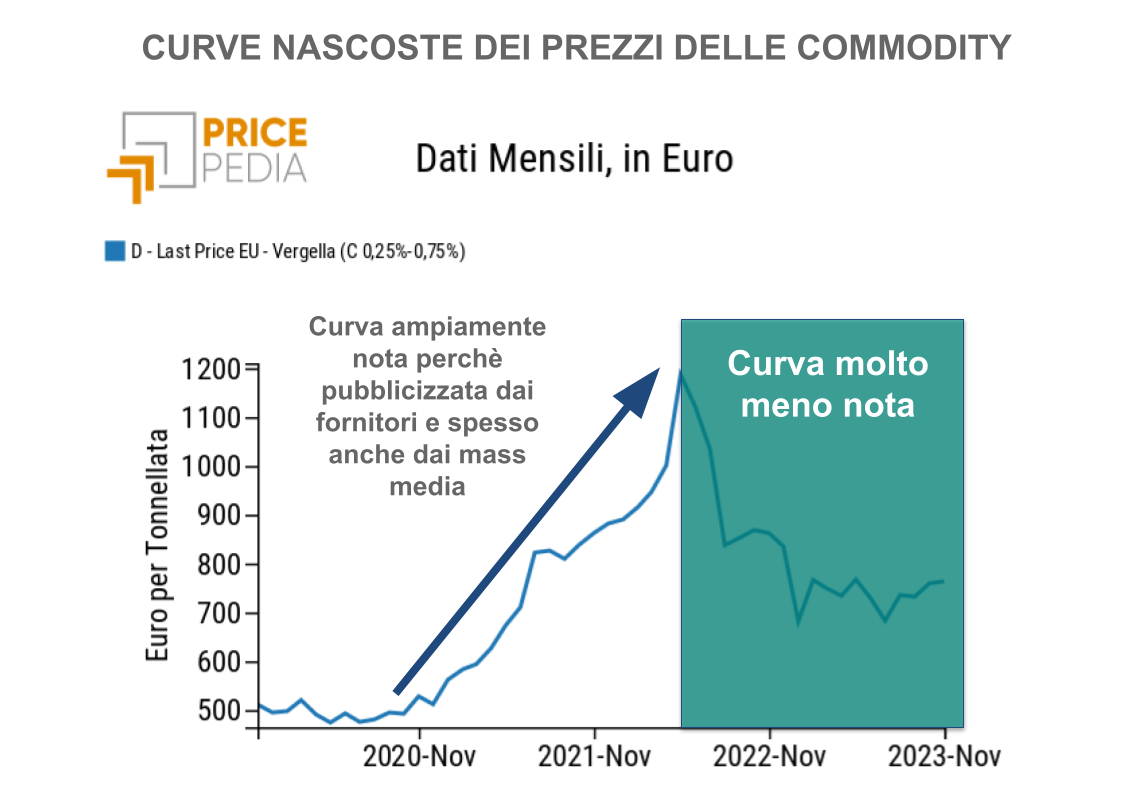Update of organic acid prices to April 2024
The European market for many organic acids is highly dependent on Chinese export prices
Published by Luigi Bidoia. .
Organic acids Global Economic Trends
Organic acid prices have also been implicated in the strong growth in
commodity prices, occurred on the European commodity markets in the two-year
period 2021-2022. Subsequently, many of them recorded a significant decrease,
significantly reducing the cumulative increase compared to 2019 levels.
The following graph shows the dynamics of the PricePedia index relating to the
aggregate of organic acids. As it turns out from the graph, the growth phase
was particularly intense: between November 2020 and June 2022, the average
prices of organic acids increased by 114%. The subsequent reduction phase was
also intense, especially in the first part: from summer 2022 to spring 2023,
average prices recorded a reduction of 26%, which continued in the following
months until the end of 2023.
In early 2024, average organic acid prices moved only sideways. Compared to
the 2019 average, in the first months of 2024, prices increased by 27%, a rate
significantly higher than that of inflation in the euro area, but
significantly lower than that of the price of oil (+38%) and, above all,
natural gas (+86%).
PricePedia price index of Organic Acids

Not all prices recorded a significant phase of reduction during the final part of 2022 and in the following months. Some prices decreased only slightly, maintaining a particularly high differential compared to the prices of 2019. In order to highlight the specificities of the different cases, in the following part an analysis of the levels of the different prices of organic acids is reported, grouped by industry of use prevalent:
- organic acids used in the food and pharmaceutical industry as preservatives, acidity regulators, flavourings, for stabilizing formulations and as excipients in medicines.
- organic acids used in the chemical industry and polymer production as precursors in the synthesis of polymers, plastics, resins and other industrial applications;
- Organic acids used in the cosmetics and personal care industry mainly for their emollient, humectant properties and as texture agents.
Organic acids for the food and pharmaceutical industries
The following table shows prices for the years 2019 to 2024[1] for organic acids used mainly in the food and pharmaceutical industries.
Price of Organic Acids (euro/tons): part 1

All prices recorded their peak point in 2022. After that, the four prices fell, but with very different intensity. On the one hand, citric acid is positioned, the reduction of which was very pronounced, so much so as to bring prices closer to the average prices of 2019. Formic acid is in an intermediate position, with significant growth compared to the highs of 2022, but with levels still high compared to the prices of 2019. The prices of benzoic acid and benzoic acid and acid lactic, the prices of which have fallen only slightly from the highs of 2022.
Organic acids for the chemical industry and polymer production
The following table shows the prices for the years from 2019 to 2024[1] for organic acids used widely by the chemical industry and for the production of polymers[2].
Price of Organic Acids (euro/tons): part 2

The first five of these prices present the traditional pattern, with intense growth in the two-year period 2021-2022, followed by a significant phase of reductions which brings their prices at the beginning of 2024 to levels not far from the 2019 prices. In addition to the shape of the dynamics of the last 5 years, these acids have in common the fact that they are derived from petrochemical sources and therefore reflect the dynamics of the price of oil and gas.
On the contrary, the price of thal oil fatty acids continued to increase during 2023, recording a trend reversal, which was very weak, only in the final months of 2023 and the beginning of 2024. The element that characterizes this acid is that it is derived from tall oil, a waste product from paper production. This makes it a product of renewable origin, the demand for which is increasing under the pressure of growing attention to the environment.
The acid that records the highest price peaks is sebacic acid, which in 2022 well exceeded the level of 5000 euros per ton. The price of European sebacic acid is strongly dependent on the Chinese one, the reduction of which has continued in recent months. The following graph compares the EU customs price of sebacic acid with the export price of the same product. The perfect alignment of the two products is evident and how the European price follows the Chinese one.
Comparison between EU price and Chinese price of sebacic acid

Organic acids for the cosmetics and personal care industry
The following table shows prices for the years 2019 to 2024[1] for organic acids used widely by the cosmetics and personal care industry.
Price of Organic Acids (euro/tons): part 3

The dynamics of the three prices are very aligned. The highest price levels were obtained from distilled fatty acids, obtained mainly from the distillation of palm and soy oil, whose price dynamics they reflect.
[1] Prices for 2024 are obtained from the average of prices in the first quarter.
[2] Among the different acids in this group, acetic acid was also considered, given its importance in the production of vinyl acetate, a monomer used in the production of polyvinyl acetate and other polymers.


